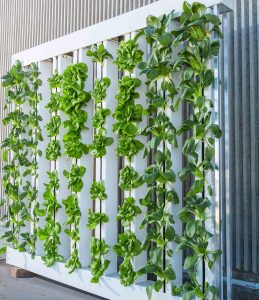The global population is rapidly expanding, and new technologies are required to enable us to keep up with rising food demands. Vertical farms provides a secure supply of food year-round while using minimal space, water, and energy. Creating the perfect environment, and especially the perfect CO2 atmosphere, in vertical farms is essential for optimizing crop yields and farm economics. Ready-to-use gas sensors such as the Boxed Gascard, from Edinburgh Sensors, allows conditions of optimum plant growth to be guaranteed.
By 2050, it is estimated that the global population will grow to 9 billion, resulting in a 59-98% increase in food demand. Despite continuous improvements in farming practices, current crop yields are growing too slowly to keep up with the predicted increase in food demand. What’s more, in the coming decades our agricultural industries must begin to adapt to changing conditions caused by climate change. Scientists around the world are investigating new and improved technologies that can revolutionize food production and enable us to keep up with food demand.
Of the 9 billion people that will inhabit the earth by 2050, it is predicted that 80% will live in cities. Vertical farms built in small urban spaces such as warehouses, sky-scrappers or even shipping containers, can provide a secure supply of local food in cities without the need for large areas of agricultural land.
Precision farming and environmental control technologies have allowed the development of vertical farms that have been reported to use 95% less water, no soil, no pesticides, and 50% less fertilizer than traditional farms while producing 75% more crops per square foot.
Countries Around the World are Investing in Vertical Farms
Many projects have demonstrated the advantages of vertical farms in pilot projects, prototypes, and at commercial production levels. A vertical farm was built in Japan after the 2011 Fukushima nuclear disaster led to a food shortage.
Commercial vertical farms have also sprung up in vacant industrial spaces in countries including Singapore, the Netherlands, and the USA. The vertical farming market is expected to grow to $13 billion by 2024, with indoor growing in urban structures predicted to represent 70% of the market.
Environmental Control for Successful Vertical Farming
Designing the perfect environment for crop growth has been the subject of a plethora of research over the past decade. It is essential to understand the effects of environmental factors on plant growth to achieve optimal crop yields and resource efficiency in vertical farms.
Temperature, light, humidity, water supply, nutrient content, and atmosphere must all be carefully controlled to ensure maximal crop yields and minimal resource use.
The effects of CO2 concentration on crop growth have been studied intensely in recent years. Small changes in atmospheric CO2 concentrations can significantly affect photosynthesis rates and plant growth, so CO2 levels in vertical farms must be carefully monitored and controlled.
CO2 levels in vertical farms can be tailored to the crop being grown, and the specific growth stage of the crops. Many studies have shown that increased CO2 levels can provide increased plant growth rates and increased water efficiency. The specific effect of CO2 levels on plant growth is dependent on the crop species and the growth stage of the plant. For example, yields of tomato plants grown in CO2 enriched conditions increased by 17%, while yields of lettuce grown in CO2 enriched conditions increased by 68%.
To ensure that optimum growth conditions are maintained, CO2 levels must be monitored and managed using gas sensing systems.
CO2 Sensors are Essential for Vertical Farms
CO2 sensors are essential for monitoring and controlling conditions in vertical farms. Sensors may be integrated with automated control systems to constantly monitor and maintain CO2 levels, providing optimal plant growth conditions without human intervention.
The most popular solutions for monitoring indoor CO2 levels are nondispersive infrared (NDIR) CO2 sensors. In an NDIR CO2 sensor, infrared light is passed through a tube of air to an infrared detector. The detector measures the light that was not absorbed by the CO2 present in the tube, and the CO2 concentration in the air is calculated. NDIR CO2 sensors are particularly popular as they provide accurate CO2 measurements, are relatively inexpensive, easy for non-experts to install and easy to operate.
The new Boxed Gascard® from Edinburgh sensors is the ideal vertical farming technology and is a ready-to-use NDIR CO2 sensor that is ideal for vertical farming applications. It uses a pseudo dual beam NDIR measurement system to provide increased stability and reduced long-term drift, with minimal optical complexity. As a result, the Boxed Gascard® provides rapid and reliable CO2 measurements. The valuable CO2 data provided by the Boxed Gascard® can be communicated to atmospheric control systems using an optional RS232 communication interface.
Find out more about Vertical Farming Technology
If you would like to know more about this exciting new NDIR CO2 sensor that promises more successful vertical farming, Edinburgh Sensors will be exhibiting the Boxed Gascard® at the Sensor and Test Measurement Fair in Nürnburg, Germany 26th-28th June, where experts will be available to talk about your specific application needs. To make an appointment, please contact Julie McCormick at Julie.mccormick@edinst.com.

